Radishes are root veggies with green leaves and a very specific aroma and taste. They come in different colors, shapes, sizes, and flavors. This veggie is very unique because its taste is zesty, spicy, and a bit bitter but at the same time.
Some types of radishes are spicier, while some are sweeter in taste. Now, let’s discuss if our guinea pigs can safely consume radishes.
Can guinea pigs eat radishes? Guinea pigs can eat radishes, but occasionally and in small serving sizes. This is because the radishes contain calcium and sodium, which are the compounds known for causing urinary stones in guinea pigs. They can also eat radish leaves, and some guinea pigs even like it more than the actual radish.
The rounded red radishes are the best radishes for guinea pigs because they have a sweeter and milder flavor compared to other types of radish. Guinea pigs shouldn’t eat very spicy food and some certain types of radishes are somewhat spicy.
In the following sections, we have provided you with even more information about radish as potential food for guinea pigs, such as benefits, risks, nutrition facts, and more. Let’s begin!
Table of Content
Are Radishes Good for Guinea Pigs? | Health Benefits
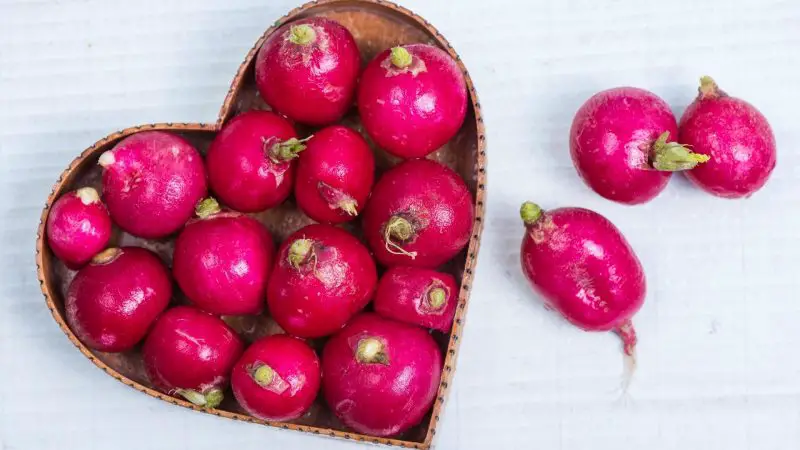
Prevention From Scurvy
Guinea pigs can’t produce vitamin C and a deficit of this vitamin can cause a serious disease called scurvy. Because of that, guinea pigs need foods that are rich in vitamin C.
Luckily, fruits and vegetables are the best sources of this vitamin. Radishes contain some vitamin C that can help prevent scurvy in guinea pigs. Also, vitamin C boosts the immune system and helps to regulate metabolism. This is an essential vitamin for guinea pig’s overall health and well being.
Good Digestion
Radishes have an average amount of dietary fiber that is good for the digestion. They improve bowel movements and the regular emptying of the bowels. So, feeding radishes to guinea pigs will help with digestion and prevent the possibility of constipation and other digestive problems.
Weight Control
The radishes are not really caloric. This means they cannot change the weight of the guinea pig. In short, there is no risk of obesity. Also, radishes have a low amount of carbs and protein too. They won’t provide much energy and this is why they are considered to be diet-friendly veggies. Low amounts of calories, fat, and sugar also help with weight loss.
Antioxidants
There are also some antioxidants in radishes that prevent the increase of free radicals in the body of your guinea pigs. Riboflavin, known as the B2 vitamin, is a nutrient that acts as an antioxidant and will convert every food in the body into energy.
Also, it promotes a better flow of oxygen in all of the cells in the organism. Vitamin C is also an antioxidant that controls the threat of free radicals, prevent cell damage, and helps with inflammation in guinea pigs.
Good for Blood and Control of the Blood Pressure
Radishes are low in fat, which is really good. This means that the cardiovascular system will stay in good health. Also, vitamin K in radishes is important for faster blood clotting, in case an injury happens.
The potassium keeps the blood pressure at normal levels. With this, the cardiovascular system will stay healthy.
There is also a small amount of copper that keeps the health of the blood vessels optimal, boosts immunity, and helps in better absorption of the iron. The iron is essential for healthy blood and it fights off anemia as well.
Help Cancer Prevention
Radishes are the part of cruciferous vegetables together with kale, broccoli, cauliflower, cabbage, bok choy, brussels sprouts, and other leafy vegetables that help with cancer prevention. They contain substances known as glucosinolates, and researches believe that they play a role in preventing cancer.
Also, these vegetables are rich in nutrients such as vitamins (vitamin C, vitamin E, and vitamin K), folate, minerals, and some carotenoids (beta-carotene, lutein, and zeaxanthin).
Nutrition Facts of Radishes for Guinea Pigs
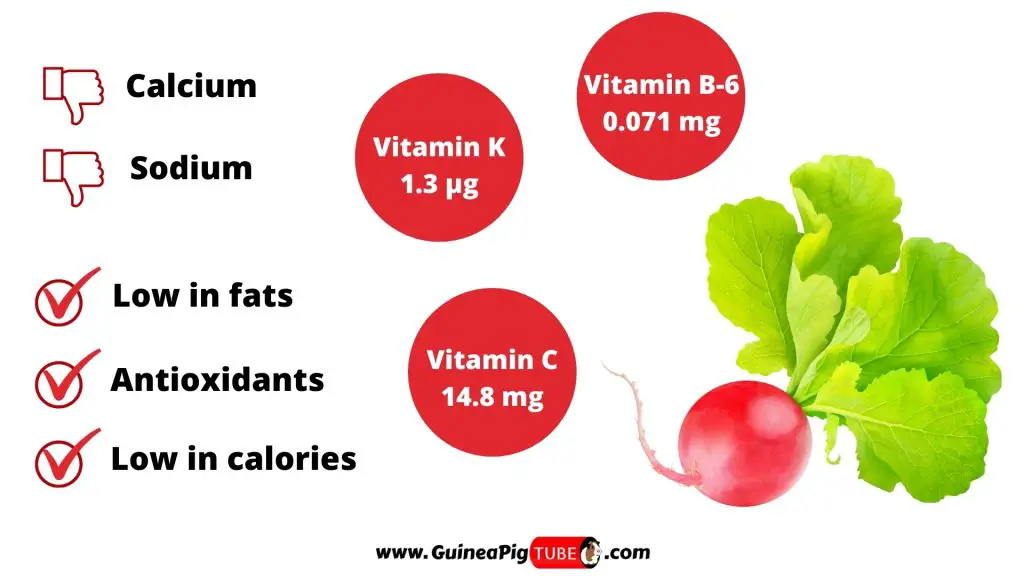
For raw radishes, 100 g (3 oz), here are the nutrients:
- Energy – 16 kcal
- Protein – 0.68 g
- Total lipid (fat) – 0.1 g
- Carbs – 3.4 g
- Dietary Fiber – 1.6 g
- Sugars – 1.86 g
- Calcium – 25 mg
- Iron – 0.34 mg
- Magnesium – 10 mg
- Phosphorus – 20 mg
- Potassium – 233 mg
- Sodium – 39 mg
- Copper – 0.05 mg
- Vitamin C – 14.8 mg
- Vitamin B-6 – 0.071 mg
- Vitamin K – 1.3 µg
- Thiamin – 0.012 mg
- Riboflavin – 0.039 mg
- Niacin – 0.254 mg
- Folate – 25 µg
- Carotene, beta – 4 µg
- Lutein + zeaxanthin – 10 µg
Risks to Consider When Feeding Radishes to Guinea Pigs
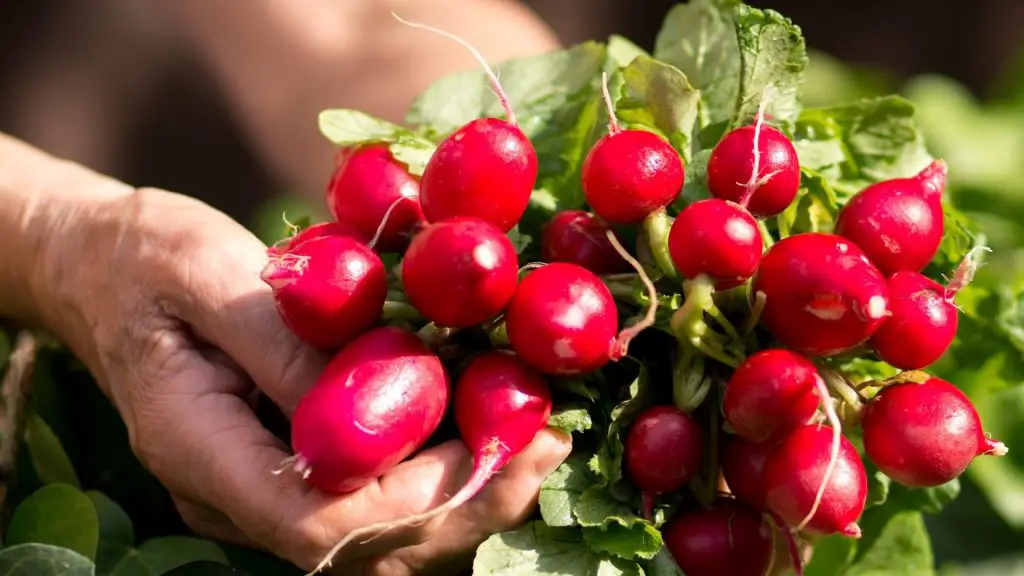
Bad Digestion
Even though the radishes have a low amount of sugar, it still needs to be regulated. In excess, the sugar will cause very painful digestion for the guinea pig in the form of cramps, loose stool, flatulence, and gasses.
Because of this, don’t give radishes to the guinea pigs very often. The specific spicy and bitter aroma of radishes can also upset the stomach of your little pet.
Urinary Complications
Radishes are rich in calcium. This mineral may help with forming strong bones, but it is not crucial at all for fully grown guinea pigs. In fact, it can cause them urinary problems like stones in kidneys and bladder, blood in urine, and frequent infections of the urinary system.
Otherwise, this mineral forms healthy bone tissues, but only when the guinea pigs are still developing and growing.
The sodium in radishes will do this as well. Studies have shown that 8 out of 10 urinary stones in guinea pigs are caused by huge amounts of calcium and sodium.
Serving Size and Frequency of Radishes for Guinea Pigs
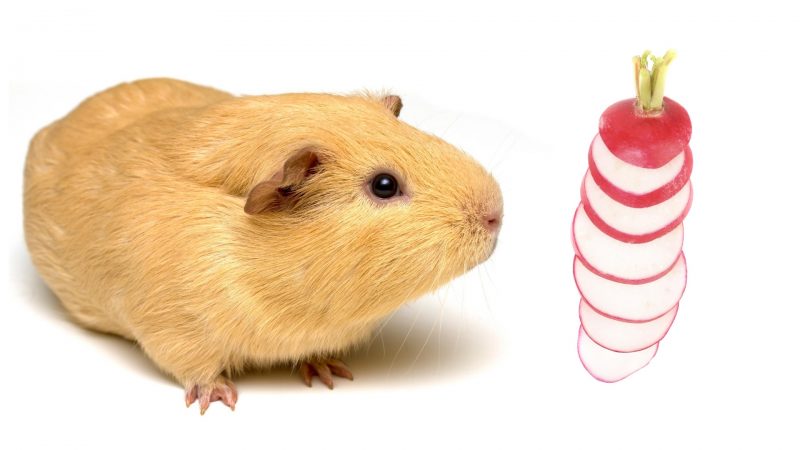
Can Guinea Pigs Have Radishes Every Day?
Guinea pigs shouldn’t eat radishes every day due to some health risks that could happen. As we have said above, radishes contain calcium and sodium that can be harmful to the guinea pig’s digestive system if fed in huge amounts and every day.
Thus, we recommend feeding guinea pigs radishes as a treat. This means one or two times per week but only in a small amount.
How Many Radishes Can Guinea Pigs Eat?
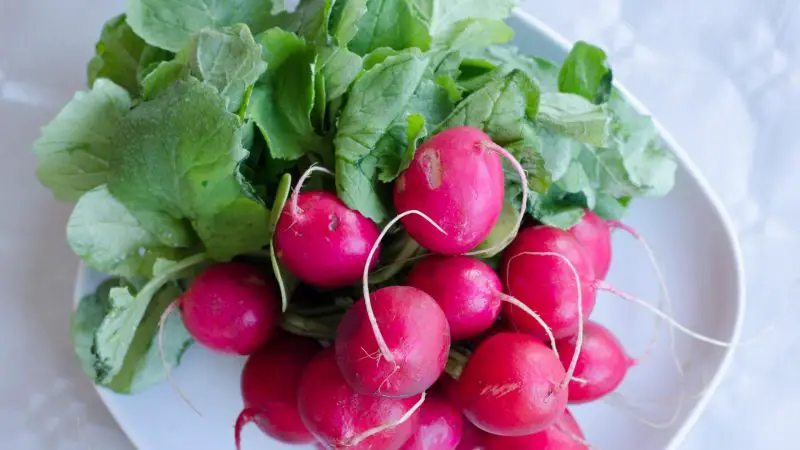
There are some risks of feeding to many radishes to guinea pigs. Therefore, we recommend giving them only one small radish or half a cup (even less for bigger radishes).
Also, be sure to provide them other vegetables besides radishes that are richer in vitamin C and that have less calcium and sodium. That way, your guinea pigs will get all nutrients that are good for their health.
Also, if you feed radishes leaves to guinea pigs, give them only one or two leaves because they contain a huge amount of calcium as well. Just be sure to wash radishes and radish leaves with water before giving them to guinea pigs.
Do Guinea Pigs Like Radishes?
Some guinea pigs do like radishes, but most of them will prefer radishes tops or leaves. This is because some guinea pigs will dislike the bitter and spicy taste of radish.
If your guinea pigs don’t like radishes, try giving them a small amount of other rooty vegetables such as carrots, turnips, swede, parsnip, and so on.
Guinea pigs also enjoy leafy vegetables such as spinach, romaine lettuce, red cabbage, kale, and many others. Consequently, it is expected that they prefer radish leaves.
Can Baby Guinea Pigs Eat Radishes?
Baby guinea pigs shouldn’t eat radishes as they need a special diet during that period. Radishes aren’t safe for guinea pigs when they are just babies because the mother’s milk should be the main part of their diet. After some period, you need to introduce them alfalfa hay, pellets, and water.
After a few weeks, you should try to give them some fruits and vegetables and food rich in calcium because it is good for their growth. Also, foods that are rich in vitamin C because it is essential for guinea pig’s growth and overall health.
More Information About Guinea Pigs and Radishes
In the following sections, find out what parts of radish can guinea pigs eat, and which types of radish are safe for them as well. Let’s start!
Can Guinea Pigs Eat Radish Leaves/Radish Tops?
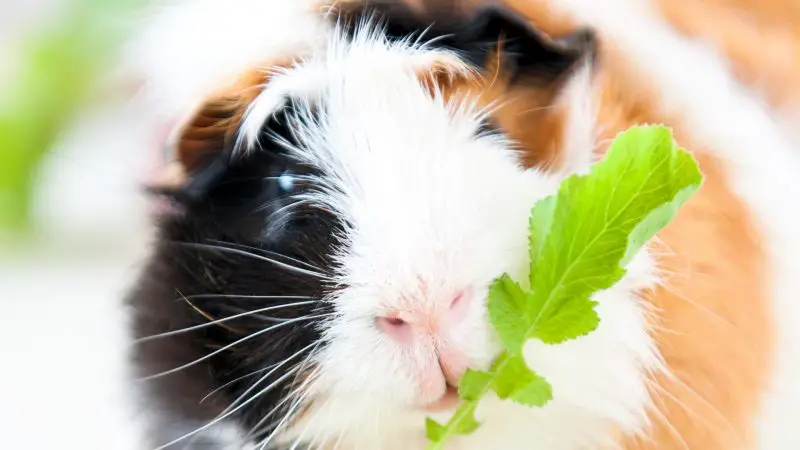
Guinea pigs can eat radish leaves and these leaves aren’t poisonous to them. On the contrary, guinea pigs sometimes enjoy eating radishes greens more than the actual radishes. Also, radish stem from the leaf is safe for them.
Radish leaves have many nutrients that are essential for the guinea pig’s body functions such as vitamin C, iron, phosphorus, and many others.
Regardless, you need to be careful with the serving sizes because radish tops also contain a lot of calcium. Feed them only one or two radish leaves and wash them thoroughly before giving to guinea pigs.
Can Guinea Pig Eat White Radish or Daikon Radish?
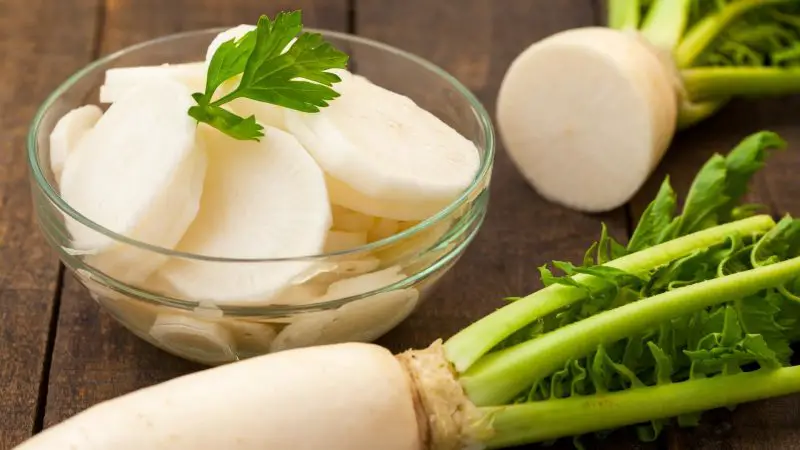
Guinea pigs can eat white radish which is also known as Daikon radish and this type of radish is safe for them. Daikon radishes are very low in calories and almost fat-free, but also rich in vitamins and minerals such as vitamin C, iron, magnesium, phosphorus, and so on.
Guinea pigs can eat white radish leaves but only in moderation, just like the case with white radishes. Give them only half a cup of white radish and one or two white radish leaves as well.
Can Guinea Pigs Eat Purple Radish?
Guinea pigs can eat purple radish. This type of radish is also a good source of many vitamins and minerals. The purple color of these radishes comes from a phytonutrient called anthocyanins which has many powerful antioxidants and health benefits.
Purple radish is also low in calories and fat, rich in vitamin C, iron, magnesium, and potassium. Still, they have calcium as well, so be careful with the serving sizes.
Can Guinea Pigs Eat Red Radishes?
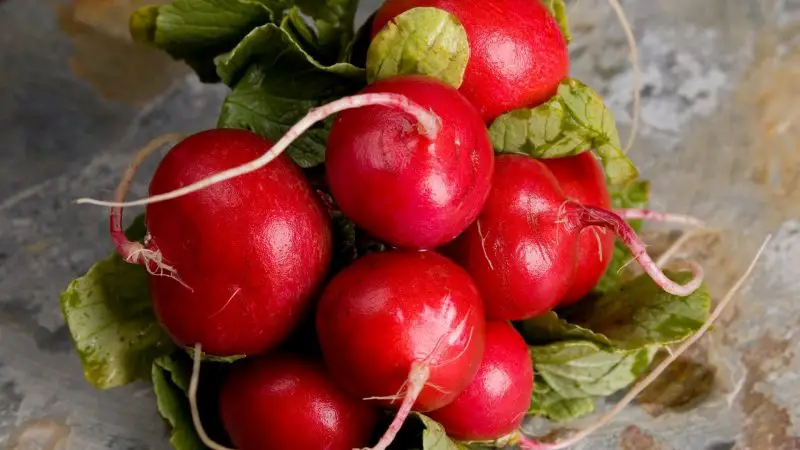
Guinea pigs can eat red radishes and these radishes have many health benefits for them. The red color of these radishes comes from the pigment called anthocyanin. These radishes are packed with fiber and many other antioxidants, vitamins, and minerals. Red radishes are also known as table radishes.
Can Guinea Pigs Eat Radish Microgreens?
Guinea pigs can eat radish microgreens and these microgreens contain various nutrients that are good for their health. Radish microgreens have a crunchy texture and a special flavor.
Moreover, they are also packed with vitamins, minerals, and proteins. These microgreens are good for a healthy digestive system, blood pressure control, immune system, and weight control.
Can Guinea Pigs Eat Radish Sprouts?
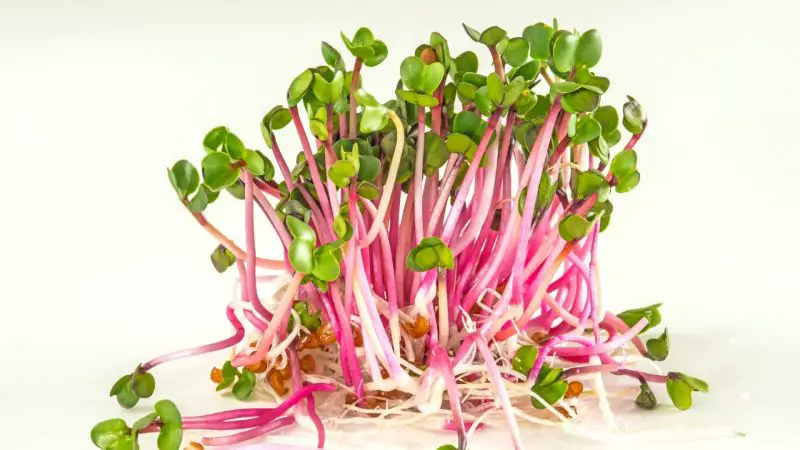
Many people confuse radish microgreens with radish sprouts. They are very similar in appearance but have some differences in taste and growth cycle.
Guinea pigs can eat radish sprouts. Similarly to radish microgreens, these sprouts are rich in many beneficial nutrients. Some of these nutrients are vitamin C, vitamin A, vitamin K but also minerals such as iron, magnesium, zinc, and so on. Feed both the radish microgreens and radish sprouts to guinea pigs in small amounts due to calcium content.
Quick Facts on Radishes
The following are some interesting facts on radishes:
- Radishes were first cultivated in China, and later in the 1500s in Europe too. In the USA, they were cultivated in 1629.
- This veggie belongs to the cabbage family. Its root is linked to cauliflower, broccoli, kale, and also horseradish.
- Also, radishes are quite similar and related to the wasabi that is used in Japanese cuisine. This is mostly for its spicy and strong flavor.
- 400 million pounds of radishes are consumed every year by Americans only.
- The term ‘radish’ simply means ‘root,’ and this term comes from the Latin word ‘radix’.
- Ancient Egyptians used the radish seed oil before olive oil became famous.
- In Mexico, there is a day celebrated as “The Day of the Radishes.” On December 23rd, they carve radishes into artworks.
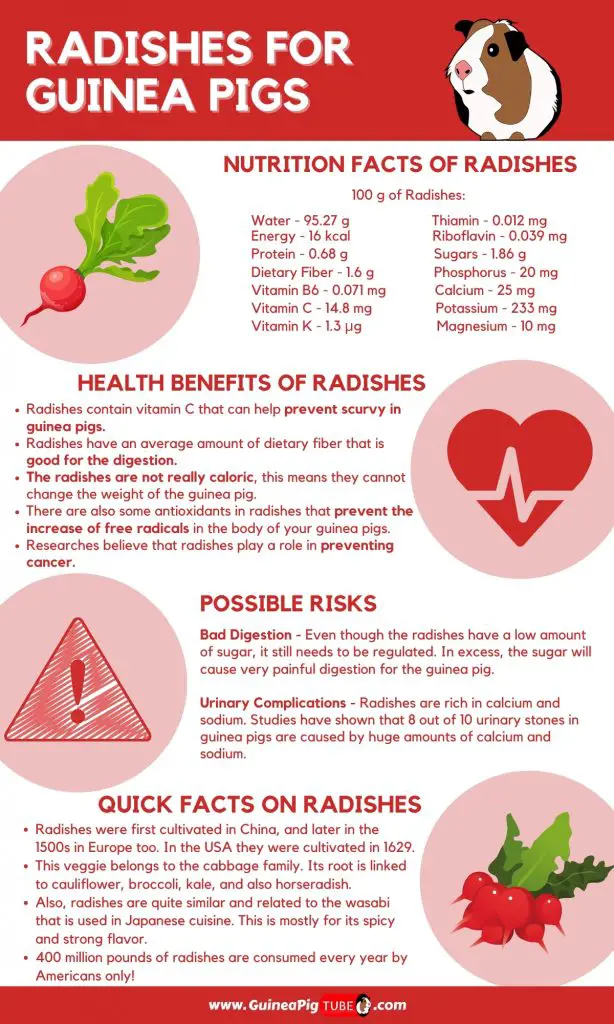
We have also made a full list of foods that guinea pigs can and can’t eat (150+ Types of Foods). Be sure to also check our recommended products page for everything you will ever need to assure a happy life for your guinea pigs. Hope this information was helpful and you have found the answer you were looking for.
List of Sources
Dietary Requirements of the Guinea Pig With Reference to the Need for a Special Factor
The Effects of Diet on Anatomy, Physiology and Health in the Guinea Pig
Deciphering the Nutraceutical Potential of Raphanus Sativus-A Comprehensive Overview
